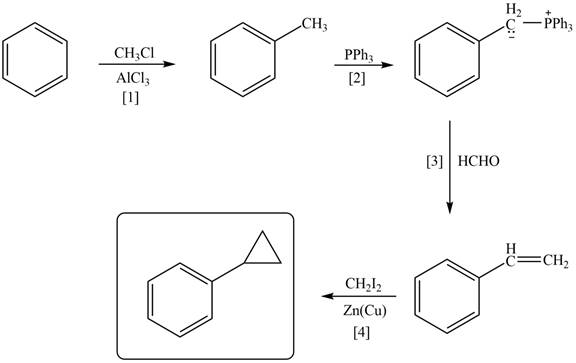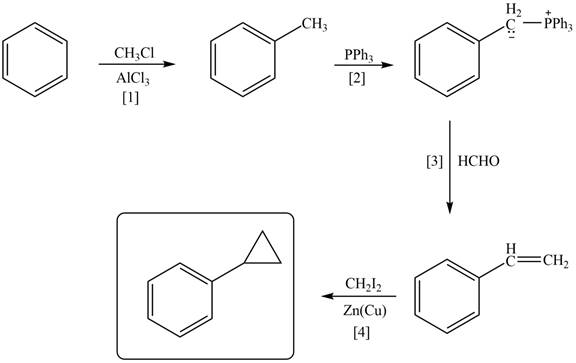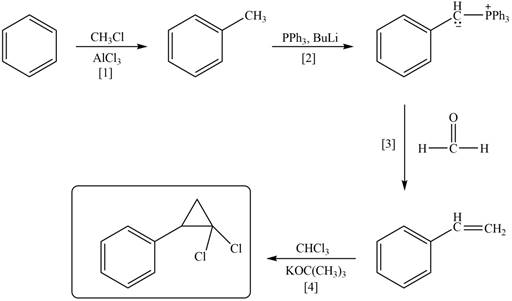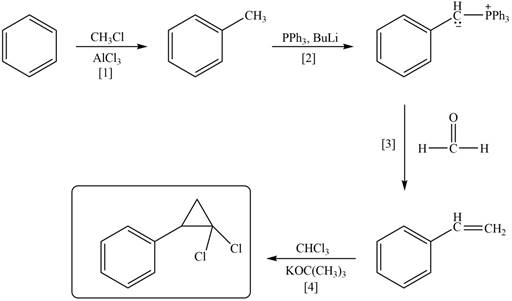
Concept explainers
Devise a synthesis of each compound from benzene. You may also use any organic compounds having four carbons or fewer, and any required inorganic reagents.
a.  b.
b.  c.
c.  d.
d. 
(a)
Interpretation: A synthesis of given compound from benzene, any organic compounds having four carbons or fewer, and any required inorganic reagents is to be stated.
Concept introduction: Cyclopropane can be formed by Smith reaction. The reaction of dihalocarbene with the alkene results in addition of carbene to the alkene and this addition takes place from either side of the plane.
Answer to Problem 26.43P
A synthesis of given compound from benzene, any organic compounds having four carbons or fewer, and any required inorganic reagents is,

Explanation of Solution
The synthesis of given compound involves three steps.
The first step is the Friedal craft alkylation reaction of benzene with

Figure 1
A synthesis of given compound from benzene, any organic compounds having four carbons or fewer, and any required inorganic reagents is shown in Figure 1.
(b)
Interpretation: A synthesis of given compound from benzene, any organic compounds having four carbons or fewer, and any required inorganic reagents is to be stated.
Concept introduction: The treatment of
Answer to Problem 26.43P
A synthesis of given compound from benzene, any organic compounds having four carbons or fewer, and any required inorganic reagents is,

Explanation of Solution
The synthesis of given compound involves four steps.
The first step is Friedel-Craft alkylation of benzene with

Figure 2
A synthesis of given compound from benzene, any organic compounds having four carbons or fewer, and any required inorganic reagents is shown in Figure 2.
(c)
Interpretation: A synthesis of given compound from benzene, any organic compounds having four carbons or fewer, and any required inorganic reagents is to be stated.
Concept introduction: The treatment of an organic halide with an alkene in the presence of
Answer to Problem 26.43P
A synthesis of given compound from benzene, any organic compounds having four carbons or fewer, and any required inorganic reagents is,

Explanation of Solution
The synthesis of given compound involves two steps.
The first step is bromination of benzene with

Figure 3
A synthesis of given compound from benzene, any organic compounds having four carbons or fewer, and any required inorganic reagents is shown in Figure 3.
(d)
Interpretation: A synthesis of given compound from benzene, any organic compounds having four carbons or fewer, and any required inorganic reagents is to be stated.
Concept introduction: The treatment of an organic halide with an alkene in the presence of
Answer to Problem 26.43P
A synthesis of given compound from benzene, any organic compounds having four carbons or fewer, and any required inorganic reagents is,

Explanation of Solution
The synthesis of given compound involves two steps.
The first step is bromination of benzene with

Figure 4
A synthesis of given compound from benzene, any organic compounds having four carbons or fewer, and any required inorganic reagents is shown in Figure 4.
Want to see more full solutions like this?
Chapter 26 Solutions
Organic Chemistry
- Devise a synthesis of each compound from cyclopentane and any other required organic or inorganic reagents.arrow_forwardDevise a synthesis of each compound from benzene, any organic alcohols having four or fewer carbons, and any required reagents.arrow_forwardDevise a synthesis of each compound from benzene. You may use any other organic or in organic reagents.arrow_forward
- Devise a synthesis of each compound from the indicated starting material:arrow_forwardDevise a synthesis of each compound from cyclohexene and any required organic compounds or inorganic reagents.arrow_forwardDevise a synthesis of each compound from benzene. You may also use any organic compounds having four carbons or fewer, and any required inorganic reagents.arrow_forward
- Devise a synthesis of each compound from aniline (C6H5NH2) as starting material.arrow_forwardDevise a synthesis of each compound from benzene. You may also useany organic compounds having four or fewer carbons and any requiredinorganic reagents.arrow_forwardDevise a synthesis of attached compound from benzene, any organic alcohols having four or fewer carbons, and any required reagentsarrow_forward
 ChemistryChemistryISBN:9781305957404Author:Steven S. Zumdahl, Susan A. Zumdahl, Donald J. DeCostePublisher:Cengage Learning
ChemistryChemistryISBN:9781305957404Author:Steven S. Zumdahl, Susan A. Zumdahl, Donald J. DeCostePublisher:Cengage Learning ChemistryChemistryISBN:9781259911156Author:Raymond Chang Dr., Jason Overby ProfessorPublisher:McGraw-Hill Education
ChemistryChemistryISBN:9781259911156Author:Raymond Chang Dr., Jason Overby ProfessorPublisher:McGraw-Hill Education Principles of Instrumental AnalysisChemistryISBN:9781305577213Author:Douglas A. Skoog, F. James Holler, Stanley R. CrouchPublisher:Cengage Learning
Principles of Instrumental AnalysisChemistryISBN:9781305577213Author:Douglas A. Skoog, F. James Holler, Stanley R. CrouchPublisher:Cengage Learning Organic ChemistryChemistryISBN:9780078021558Author:Janice Gorzynski Smith Dr.Publisher:McGraw-Hill Education
Organic ChemistryChemistryISBN:9780078021558Author:Janice Gorzynski Smith Dr.Publisher:McGraw-Hill Education Chemistry: Principles and ReactionsChemistryISBN:9781305079373Author:William L. Masterton, Cecile N. HurleyPublisher:Cengage Learning
Chemistry: Principles and ReactionsChemistryISBN:9781305079373Author:William L. Masterton, Cecile N. HurleyPublisher:Cengage Learning Elementary Principles of Chemical Processes, Bind...ChemistryISBN:9781118431221Author:Richard M. Felder, Ronald W. Rousseau, Lisa G. BullardPublisher:WILEY
Elementary Principles of Chemical Processes, Bind...ChemistryISBN:9781118431221Author:Richard M. Felder, Ronald W. Rousseau, Lisa G. BullardPublisher:WILEY





